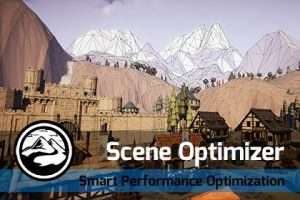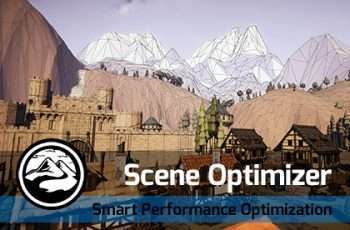
This is a paid asset, but now you can download the “Scene Optimizer” for FREE, Please keep in mind this package is provided only for learning purposes or to be able to test before buying the product, NOT FOR COMMERCIAL PURPOSES.
For more detail this asset from the Unity Asset Store: Click Here
Scene Optimizer v1.1.3
Speed up your game with just a few clicks.
Do you want your gaming performance to improve?
Faster frame rates mean you can reach more viewers and provide a richer, more satisfying experience. However, scene optimization is a time-consuming process that often resembles black magic.
Scene Optimizer was born from professional VR and mobile optimization work for our customers. We’ve automated various techniques to easily deliver better frame rates with just a few clicks.
The performance gains you get will depend on how you build your scene, what your game play is, where you are, and what you ask of the scene optimizer.
The best improvements are seen in scenes with a large number of game objects, typically when using low-polygon or modular assets.
The Scene Optimizer allows you to easily and quickly iterate through optimization techniques until you find the best fit for your scene.
How does Scene Optimizer work?
Because one approach rarely fits all scenarios, Scene Optimizer takes a hybrid approach to optimization. Simply drop your object tree into the Scene Optimizer and tell it the combination of techniques you want to perform.
Scene Optimizer performs settings and automates scene optimization. This reduces weeks of work to minutes and provides a frame comparison system that shows the impact, encouraging you to experiment with which approach works best.
Intelligent mesh cutting and joining
Scene Optimizer understands that the way you work with rocks and grass is completely different from the way you work with buildings and mountains.
The Scene Optimizer uses a combination of size, spatial partitioning, and mesh merging to create intelligent objects that significantly reduce draw calls and shadow generation, and also assists in the culling process.
The scene optimizer can also split large meshes into smaller meshes and change indexes to 32-bit on request to improve performance on mobile and VR devices.
Most modern mobile and desktop GPUs render one large mesh much faster than many smaller meshes, so this can significantly improve performance.
Layer-based distance culling
The Scene Optimizer can also automate the generation of meshes at different layers and provides an easy system to control shadows and draw distances based on the size of the original object.
This makes small objects less visible at a distance and allows larger objects that are farther away to continue rendering, allowing them to be culled more quickly. This can be easily adjusted and can have a significant impact on rendering performance.
Occlusion culling
Unity has a built-in occlusion culling system that is great when used properly, but when used incorrectly it can actually be much slower than no occlusion culling at all, especially in open world situations. There is a possibility that
The Scene Optimizer helps with occlusion culling, especially for large numbers of small objects such as grass and groundcover, by turning potentially millions of culling decisions into a relatively small number of larger culling decisions. This reduces CPU load and can have a significant impact on game performance.
Scene Optimizer Tips
The Scene Optimizer should be considered as a useful helper to save time during more general optimization processes.
For large open-world scenes, you should enable layer-based culling in the settings and fine-tune the results. Typically, the greatest benefit is achieved by reducing draw calls and shadows on small grasses, rocks, and bushes. Select your camera and experiment with and fine-tune the culling distance. Reducing the draw distance for small and medium-sized objects can significantly improve rendering.
Occlusion culling is not recommended for flat open-world scenes where there is nothing to occlude. There is no benefit to the additional CPU overhead. For maximum benefit, design your scene with natural or man-made obstacles. Stand behind them and see them in action.
Some vegetation shaders move vertices to simulate wind, but they often break when combined. You can still use the Scene Optimizer in your scene, but make sure these objects are excluded.
Bonus – Object Placement Tool
Added a tool to quickly align objects to the ground/slope of the underlying terrain. This is useful when moving selected objects to different locations on the terrain.

